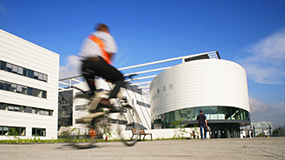 Recherche
Recherche
Laboratoires.Ecoles, Collège et Formation doctorales
Stratégie. Séminaires, colloques. Sciences et société
Réseaux et pôles d'excellence. Investissements d'avenir (Labex)
Premières rencontres langues et sciences
Ce podcast présente les communications des "Premières rencontres langues et sciences" dont l'objectif est de mettre en lumière les enjeux linguistiques des formations ouvertes à l'international.
One dimension that we can discuss when considering using a second language in higher education is the extent to which language learning is structured as a course component. The two poles are Content and language integrated learning and second-language-medium instruction.
CLIL is a teaching approach in which language and disciplinary content are equally targets of the learning process. Learning outcomes are specified for both targets, both types of learning product are tested, and teaching is adapted to the demands of both learning processes. SLMI (or English-medium instruction as we may call it in this context), by contrast, is the use of a language which is not the learners’ first language to learn a discipline. This may have the incidental effect that proficiency in the second language is improved in some areas, but this is not a specified learning outcome.
A second dimension is the extent second-language use required. In Scandinavia, for example it is very common for textbooks to be in English while all teaching and testing is in the first language. Sometimes lectures and reading are in the second-language, but discussion and examination in L1, the first language. Sometimes students can choose which language to express themselves in. Finally, some versions of CLIL and SLMI forbid participants from using L1 at all.
A third dimension is the status of the second language in the social context. How mature are the students? How much disciplinary knowledge do they have? How much exposure have students had to L2 in speech or writing? Are they familiar with films, books, television, Wikipedia in the second language? How similar is terminology in L1 and L2? How confident and proficient are teachers and learners in the L2? Is teaching in L2 mainly to accommodate international students, or is it mainly for local students?
My presentation discusses these dimensions of difference, focusing to some extent on Scandinavian and Spanish experience, and then considers what might be appropriate decisions in other contexts and the implications for teaching and testing techniques of these decisions.
One dimension that we can discuss when considering using a second language in higher education is the extent to which language learning is structured as a course component. The two poles are Content and language integrated learning and second-language-medium instruction.
CLIL is a teaching approach in which language and disciplinary content are equally targets of the learning process. Learning outcomes are specified for both targets, both types of learning product are tested, and teaching is adapted to the demands of both learning processes. SLMI (or English-medium instruction as we may call it in this context), by contrast, is the use of a language which is not the learners’ first language to learn a discipline. This may have the incidental effect that proficiency in the second language is improved in some areas, but this is not a specified learning outcome.
A second dimension is the extent second-language use required. In Scandinavia, for example it is very common for textbooks to be in English while all teaching and testing is in the first language. Sometimes lectures and reading are in the second-language, but discussion and examination in L1, the first language. Sometimes students can choose which language to express themselves in. Finally, some versions of CLIL and SLMI forbid participants from using L1 at all.
A third dimension is the status of the second language in the social context. How mature are the students? How much disciplinary knowledge do they have? How much exposure have students had to L2 in speech or writing? Are they familiar with films, books, television, Wikipedia in the second language? How similar is terminology in L1 and L2? How confident and proficient are teachers and learners in the L2? Is teaching in L2 mainly to accommodate international students, or is it mainly for local students?
My presentation discusses these dimensions of difference, focusing to some extent on Scandinavian and Spanish experience, and then considers what might be appropriate decisions in other contexts and the implications for teaching and testing techniques of these decisions.

Commentaire(s)